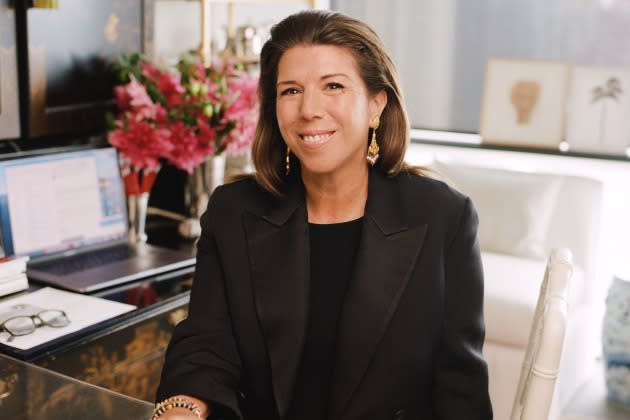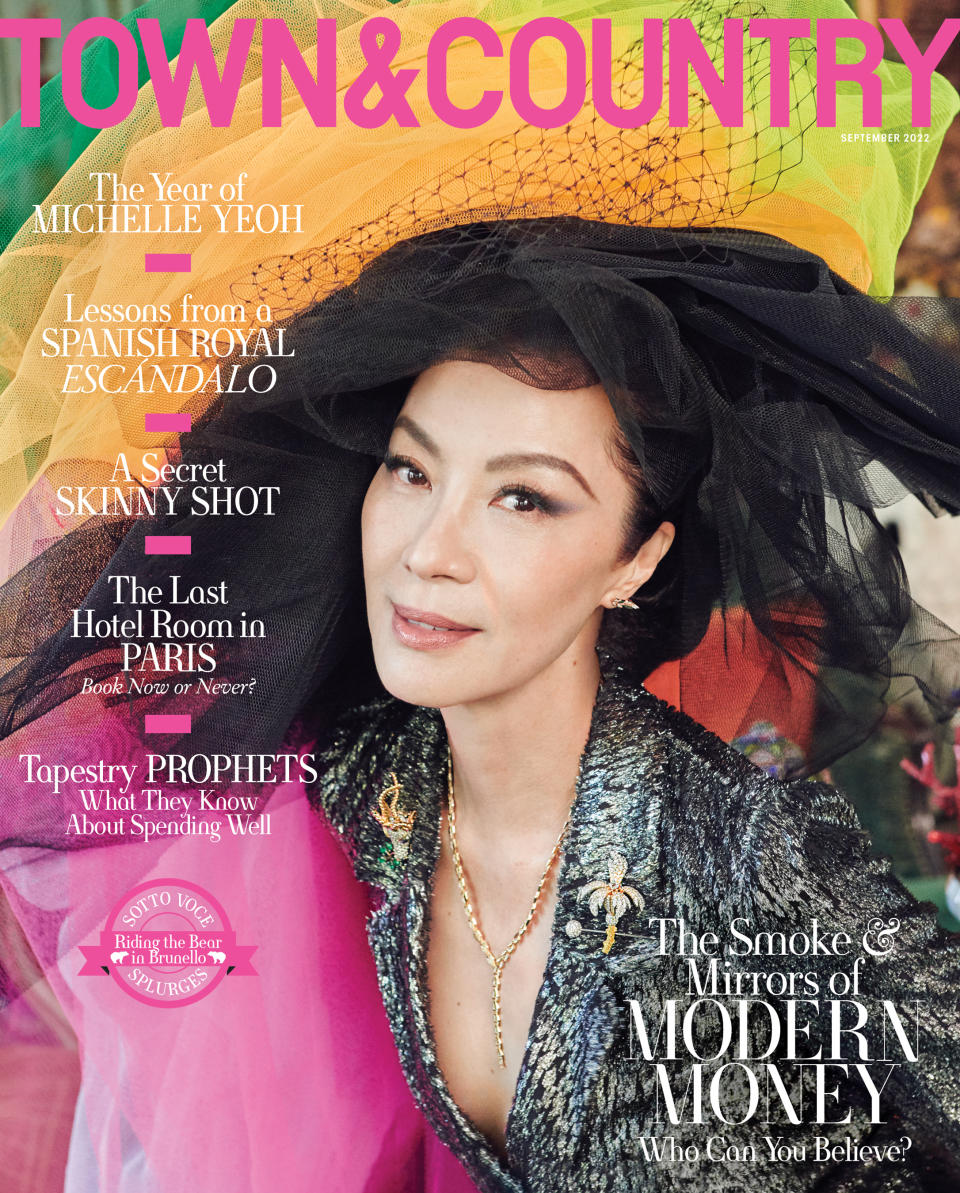Media People: Stellene Volandes on the Importance of a Well-placed Question Mark

For Stellene Volandes, the editor in chief of Town & Country — the 176-year-old (this October) glossy that chronicles the high life and, occasionally, the moral failings of the great and good — the pandemic offered few silver linings.
An avowed Broadway fan, Broadway was dark. A voracious traveler with a large extended family in Greece, flights were grounded, with family time relegated to Zoom. A jewelry expert who has authored an anthropological tome on the art form, there were — at least early in the pandemic — exactly zero occasions to don her Verdura.
More from WWD
As restrictions have eased, Volandes’ enviable magazine-editor’s life — as chronicled on Instagram for her 88,000-plus followers — has a distinct YOLO bent. Some highlights: an anniversary dinner for “Lucky Chow” co-host and T&C contributor William Li and James Oates in Umbria; a Greek National Opera performance of “Tosca” at the ancient theater of Herodion at the Acropolis; a peek at Francesca Amfitheatrof’s new high-jewelry collection for Louis Vuitton in Marrakech; at Yves Saint Laurent’s Villa Oasis, also in Marrakech; Paris Couture Week, where she also took in the Paris Opera Ballet’s “Midsummer Night’s Dream” and dined at Le Voltaire; a preview of Christie’s Paris Givenchy auction; visiting the White House as President Biden and Dr. Jill Biden welcomed Greece Prime Minister Kyriakos Mitsotakis and his wife Mareva Grabowski-Mitsotakis. And that’s only since May.
“I was anxious to return to the dance,” says Volandes. “And I am back at the dance. In heels and jewelry.”
Volandes, 51, who was elevated to the top of the masthead of the Hearst-owned Town & Country in 2016, is not simply putting together a luxury magazine. She’s a living, breathing version of it. She can tell you which Broadway shows to see, where all of the best — and most exclusive — restaurants are, from New York to the tiniest village in Greece. She can advise you on which handbag will still be au courant in a decade. And she can (and does in the pages of the magazine) hold forth on the legacy of the world’s most famous green diamond (and no, it’s not on Jennifer Lopez’s ring finger).
“She really lives the life of the magazine,” says her friend Hanya Yanagihara, the author and editor in chief of T Magazine. “She really knows her reader. She loves being an editor in chief, which sounds obvious, but I think some people actually really like it more than others. And she really finds a lot of joy doing it.”

Ruven Afanador/Courtesy Town & Country
Once the coffee table accoutrement of Mayflower blue-bloods, Volandes’ Town & Country is a carefully curated lifestyle magazine about the best of everything (fashion, beauty, travel, food) that also chronicles new money and old-world society with a winking eye and a deftly deployed headline. Which means you are as likely to find stories about $6,000 handbags and Golconda diamonds as you are about an internecine squabble between denizens of Laguna Beach over a nine-foot, $1 million backyard Dale Chihuly sculpture and the new rules of college admissions, where “the merely rich and only sort of powerful attempt to secure Ivy League admission spots without the old bag of tricks,” as the display copy on a society story from the May issue teases.
“We cover the world of our readers, but we also cover our readers,” Volandes explains. “We cover wealth as a journalistic subject. What are the responsibilities of [wealth]? We have a whole issue dedicated to philanthropy. What are the absurdities of wealth?”
The latter are what Volandes calls “the crazy money stories.”
“Stellene brings an intellectual heft and skepticism to society [coverage],” says Kate Lewis, chief content officer for Hearst Magazines. “And she’s the deftest headline and display writer in the business.”
That gimlet eye, says Volandes, is perfectly on brand.
“There’s a 1961 cover and it is [a photo] of the writer Cleveland Amory smoking a cigarette. And the only cover line is: Society. Question mark. And the thing that some people still do not understand about T&C is the question mark. But that question mark is at the core of every single thing we do,” she says.
One thing there is little question about is the survival of the brand in all of its in-real-life glory. In an era of dwindling print publications many Hearst titles, including Town & Country, have had their print issues downsized. But the company is fully committed to maintaining a print product.
“We are pretty bullish on print,” says Lewis. “We are privileged to create a product in this media landscape that consumers want to have in their hands. Like a lot of fashion brands, photography is 50 percent of the story. And that representation really thrives on a big, lovely, beautifully printed sheet of paper. And so to me, it feels foundational to the brand.”
The magazine publishes nine times each year and also hosts several signature events, including its annual Philanthropy Summit, which will return to the in-person format this fall. Town & Country has seen its print and digital revenue rebound after the industry-wide decline in advertising at the outset of the pandemic. In June, the magazine’s site notched more than 13 million unique users, a 14 percent year-over-year increase. (Print circulation is tiny by comparison — 443,075 as of June 2021, according to the Alliance for Audited Media.) Video has grown 31 percent and e-commerce, which has become increasingly critical for legacy media brands, was up 54 percent year-over-year. Top e-commerce earners were stories about luxury bedding and high-end mail-order butchers.
Volandes’ entrée into the world of magazines came when she landed a job as an assistant to Richard David Story, an early mentor, and Michael Boodro at Vogue. She took a detour to earn a master’s degree in English and comparative literature from Columbia and then taught English for two and a half years at LaGuardia High School. When she decided she wanted to return to publishing, Story, by then at Departures, gave her a job. When eventually the Departures’ jewelry editor was retiring, Story tapped Volandes to succeed her. “He said, ‘I think you should cover the jewelry market. You wear a lot of it. You have this whole Greek thing,’” she recalls.
She worked her way up the ladder at Departures, becoming style editor in 2007. She left in 2011 to become jewelry and accessories director for Town & Country; the following year she was promoted to style director. When then-T&C editor in chief Jay Fielden was tapped in 2016 to run Hearst-owned Esquire, Volandes was the obvious candidate to succeed him.
Much has changed in the industry; budgets and staffs have been curtailed, expense accounts aren’t quite as lavish and social media has made would-be whistleblowers of the industry’s armies of low-paid assistants. The economics and challenges of the business in the post-digital, social-media-fueled era means “you have to hustle a bit more to make things happen,” concedes Volandes. At the same time, the new reality has engendered a comity that was in short supply during the hyper competitive heyday of the glossies.
“When I was growing up in the industry, editors at other magazines did not speak to each other,” she says. “You would sit next to people at shows or see people at appointments, and you would just stare straight ahead. Now we’re all rooting for each other. And many of us are close friends. And if there’s a great cover — from inside the building, or outside the building — I post in on my Instagram. Because whenever and whoever is making that magazine magic, it’s inspiring me.”
Sign up for WWD's Newsletter. For the latest news, follow us on Twitter, Facebook, and Instagram.


